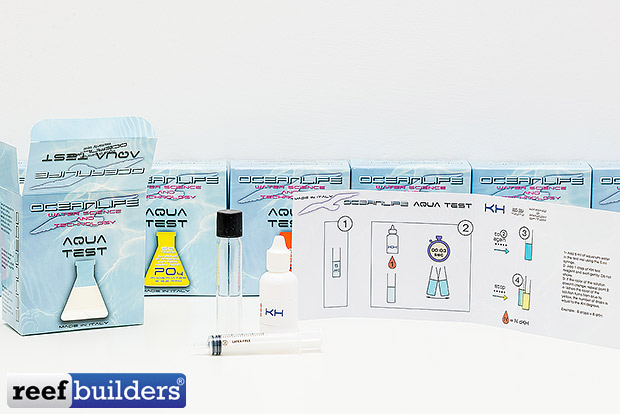A few weeks ago Oceanlife presented it’s new aquarium test kit line and we have been highlighting these kits here on Reef Builders. Today we will speak more in depth about the carbonates test kit (Kh). As you can see from the picture the test is composed of a box of generous dimensions that contains the folding carton reference card with instructions in English illustrating each step, a glass test vial, a flask containing the reagent called Kh and a syringe.
Oceanlife estimates this test kit is given for 50 averaged measurements but the number of measurements depends strongly from the values measured in your the aquarium. Each test varies and each measurement may have a different number of drops used indicating your current parameter level. For example, if there are 50 test if your aquarium’s carbonate level is at 8 dKh, it would mean 33 kh test at 12 dKh, and obviously even less in the case of test measurements of dKh into the calcium reactor.
The test is extremely simple. Just fill the vial with 5 ml of aquarium water, then put a drop of reagent from the Kh bottle and agitate the vial gently for three seconds to observe whether there is a change of color from blue to yellowish orange. If there were no change we repeat the previous two steps, drop of solution and agitate, until the color change has occurred. At that point, the number of drops used equal to the value in degrees of carbonate hardness or dKh (e.g., if eight drops are needed, this would equal to 8 dKh, and so on).
Obviously it is always possible to vary the amount of water inside the vial to obtain a greater or lesser resolution. Using 10 ml of aquarium water every drop of reagent will be equivalent to 0.5 dKh, whereas decreasing the water in the vial to 2.5 ml each drop would equal to 2 dKh, and using only one ml of water we will have the equivalence between one drop equal to 5 dKh. This can be useful to get an idea of dKh values inside your calcium reactor without emptying the reagent bottle.
As with other test kits uses a dropper, the exact measurement of each drop is not precise since sometimes the drops are larger or smaller or some air is in the dropper tube. That said, the the test is inexpensive costing €9.40 in Europe (around $12 USD), even when compared with the Elos test which costs €12.36, often considered among the best on the market, there is not a huge difference. Besides the two tests use the same mode of measurement and the same reagent, the only difference is drops maker and a greater dilution for Elos test kit, where each drop corresponds to 0.5 dKh.
Taking a comparative test on my reef aquarium with two brand new test Elos and Oceanlife I measured several times the exact same value, thus eliminating the need for a better dropper, or at least mitigating its importance. In any case we recommend to use 10ml of water to have a higher resolution. Of course, in this way you will make half of the measurements budgeted since you have to use twice as many drops.
Do remember that all tests, although they have a high number of measurements, should be used not more than six months from their first use. Incorrect storage can ruin the reagents and give you false readings. Considered the six-month reference period and 50 measurements means that with this test we can make about two reading a week for a period of six months, at a cost of about €0.19 per measurement with 1 dKh resolution or one reading a week at €0.38 each with 0.5 dKh resolution.



